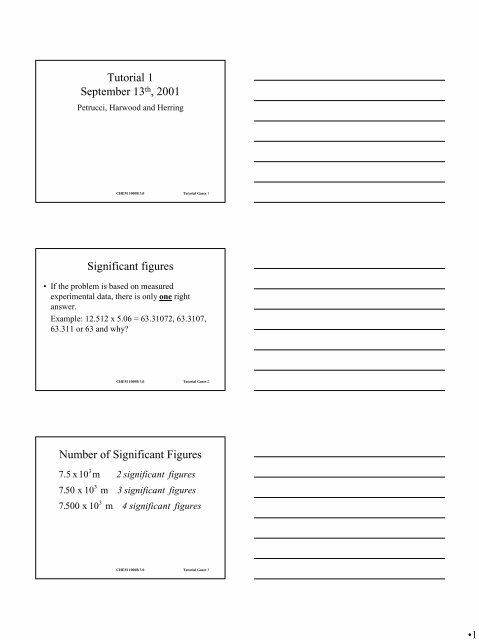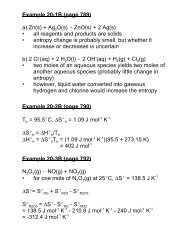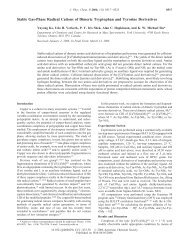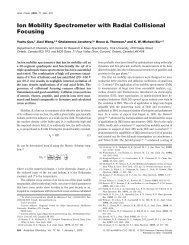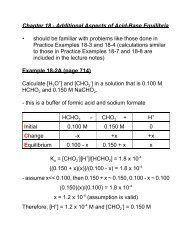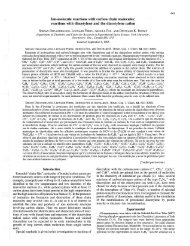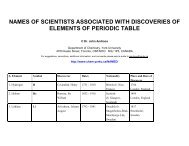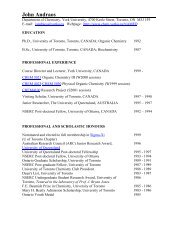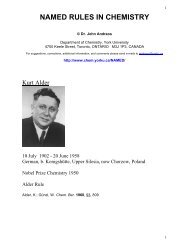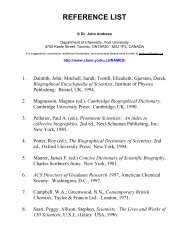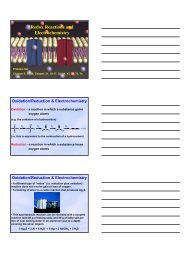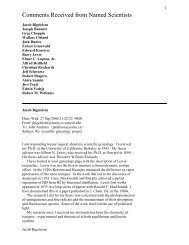Tutorial 1 September 13th, 2001 Significant figures Number of ...
Tutorial 1 September 13th, 2001 Significant figures Number of ...
Tutorial 1 September 13th, 2001 Significant figures Number of ...
You also want an ePaper? Increase the reach of your titles
YUMPU automatically turns print PDFs into web optimized ePapers that Google loves.
•1<br />
<strong>Tutorial</strong> 1<br />
<strong>September</strong> 13 th , <strong>2001</strong><br />
Petrucci, Harwood and Herring<br />
03/10/01 CHEM 1000B 3.0 <strong>Tutorial</strong> Gases 1<br />
<strong>Significant</strong> <strong>figures</strong><br />
• If the problem is based on measured<br />
experimental data, there is only one right<br />
answer.<br />
Example: 12.512 x 5.06 = 63.31072, 63.3107,<br />
63.311 or 63 and why<br />
03/10/01 CHEM 1000B 3.0 <strong>Tutorial</strong> Gases 2<br />
<strong>Number</strong> <strong>of</strong> <strong>Significant</strong> Figures<br />
7.5 x 10<br />
3<br />
7.50 x 10<br />
m<br />
3<br />
7.500 x 10<br />
3<br />
m<br />
m<br />
2 significant <strong>figures</strong><br />
3 significant <strong>figures</strong><br />
4 significant <strong>figures</strong><br />
03/10/01 CHEM 1000B 3.0 <strong>Tutorial</strong> Gases 3
•2<br />
In scientific notation: 4.004500 x 10 -3<br />
03/10/01 CHEM 1000B 3.0 <strong>Tutorial</strong> Gases 4<br />
Round-Off Errors<br />
•Using sig. figs. properly avoid round-<strong>of</strong>f errors<br />
!if the last digit is 0 to 4, don’t change the<br />
previous digit<br />
!if it is 5 to 9, raise the previous digit by 1.<br />
Example: if the correct number <strong>of</strong> sig. figs. is (2),<br />
67.3 or 67.0 round <strong>of</strong>f to 67<br />
but 67.5 or 67.9 round <strong>of</strong>f to 68<br />
03/10/01 CHEM 1000B 3.0 <strong>Tutorial</strong> Gases 5<br />
Example:<br />
97x ½ x ½ x ½ = 97/8 = 12.125 or 12 (2 sig.figs)<br />
97 x ½ = 48.5 = 49<br />
49 x ½ = 24.5 = 25<br />
25 x ½ = 12.5 = 13 (2 sig. Figs.)<br />
03/10/01 CHEM 1000B 3.0 <strong>Tutorial</strong> Gases 6
•3<br />
Exact <strong>Number</strong>s and Physical Constants<br />
•When we find ½ <strong>of</strong> a number, we mean x<br />
0.50000000…; the ½ is know to an infinite number<br />
<strong>of</strong> sig. Figs., and doesn’t affect the number <strong>of</strong> sig.<br />
Figs. In the answer.<br />
Such exact numbers are <strong>of</strong>ten present in<br />
formulae; e.g. kinetic energy KE = ½ mν 2<br />
This is true also for π = 3.141592654… as in the<br />
area <strong>of</strong> a circle A = π r 2<br />
03/10/01 CHEM 1000B 3.0 <strong>Tutorial</strong> Gases 7<br />
•Even the common physical constants<br />
e.g. the gas constant R = 8.31451 J mol -1 K -1 =<br />
0.0820584 L atm mol -1 K -1<br />
are known to enough sig. figs. so that they seldom<br />
limit the number <strong>of</strong> sig. figs. in the answer.<br />
Use all the available digits in your calculations.<br />
03/10/01 CHEM 1000B 3.0 <strong>Tutorial</strong> Gases 8<br />
In practice, the correct handling <strong>of</strong> sig. figs. can be taken<br />
care <strong>of</strong> by a few simple Rules.<br />
1. Put all the data into the calculation using all the digits<br />
you’ve got.<br />
2. When you multiply and/or divide numbers, it is the<br />
number with the fewest sig. figs. which controls the<br />
answer.<br />
3. When you add and/or subtract numbers, it is the number<br />
with the fewest decimal places which controls the<br />
answer.<br />
03/10/01 CHEM 1000B 3.0 <strong>Tutorial</strong> Gases 9
•4<br />
<strong>Significant</strong> <strong>figures</strong><br />
• If the problem is based on measured<br />
experimental data, there is only one right<br />
answer.<br />
Example: 12.512 x 5.06 = 63.31072, 63.3,<br />
63.311 or 63 and why<br />
Answer: 12.512 x 5.06 = 63.3 (3 sig. figs)<br />
5 sig. figs<br />
3 sig. figs<br />
03/10/01 CHEM 1000B 3.0 <strong>Tutorial</strong> Gases 10<br />
The 1.000 kg red cylinder<br />
has a diameter <strong>of</strong> 4.10 cm. What<br />
pressure, expressed in Torr, does<br />
this cylinder exert on the surface<br />
beneath it<br />
What substance is this<br />
cylinder made <strong>of</strong>, could it be Hg<br />
03/10/01 CHEM 1000B 3.0 <strong>Tutorial</strong> Gases 11


